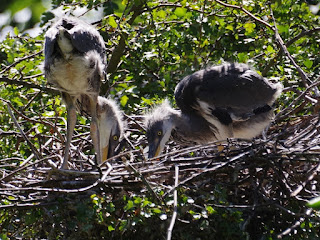It was a windy day, so there was no sign of the Little Owl at the leaf yard. He goesn't like getting his feathers ruffled.
The Grey Heron chicks in the nest were preening. It seems to be a universal rule with young birds that when they see the parent preening they preen too.
The chicks shared a fish. I still haven't got a picture of a fish being brought by a parent. Since the chicks can peck apart and share a large fish, they don't need feeding very often.
The two teenage herons were on either side of the path at the east end of the Serpentine. One looked as if it was picking blackberries, though in fact it was waiting for a fish to come out of the reed bed.
The other stood motionless on a rock at the top of the waterfall. Visitors often think they're plastic ornaments.
The Great Crested Grebe chicks at the bridge were clamouring noisily to be fed.
At the island, one of the parents shook the chicks off while the other waited to let them climb aboard.
A Coot family on the Long Water ate both the thick growth of duckweed and any small creatures they found in it.
The six new Moorhen chicks in the Italian Garden fountain wandered among the water lily leaves. The heavier teenager had a harder time getting around in the clump.
The teenager carefully explored a flower, looking for insects.
The six Tufted ducklings at the bridge are growing noticeably larger. They are as frantically active as ever.
The Coot nest that was occupied by this family yesterday had an Egyptian Goose on it today. The Coots won't be able to reclaim it any time soon.
The undersized Egyptian gosling was with its larger siblings, or perhaps step-siblings. Last year there was another very small gosling and I thought it had been adopted, but in fact it stayed small and grew into a very undersized adult. I last saw it a couple of months ago, looking perfectly healthy.
This sunflower near the bridge is an accidental arrival caused by people feeding the small birds with sunflower seeds. It has attracted two different kinds of bumblebee. A sunflower is a composite flower, with hundreds of little nectar-bearing flowers forming its centre, and it takes the bees some time to work their way over it.
Here is a close-up of the same bees.










We are from the US and visited London a couple weeks ago. The highlight of the trip for our children was the waterfowl of Hyde Park, particularly the Great Crested Grebes. We are delighted to find your blog to keep up on the birds. Thanks for putting together a lovely and informative blog and for making us feel that we are right there watching the chicks grow up.
ReplyDeleteThank you for your kind words, and for reading the blog.
DeleteAny chance that Egyptian will actually use the Coot's nest? Jim
ReplyDeleteAlmost certainly not. They nest in tree holes for preference, though I have seen nests in reed beds. Most likely it was just a comfortable place to rest.
DeleteNice photo of the bees- they rarely stay still for me! You can see the Red-tailed is a male with the yellow band on the thorax (+ no pollen baskets).
ReplyDeleteA sunflower is a wonderful way of keeping bees in the same place for minutes at a time.
DeleteLove the close up of the bee! The colours make the scene so cheery and happy. It reminds me of hours spent walking through sunflower fields (in the interest of truth, there was nothing bucolic abut it: they were commercial plantations) when I was little.
ReplyDeleteSo the unstoppable Coot finally met the inmovable object (the Egyptian)...
And today the Tufted Ducks are back on the Coots' nest.
Delete